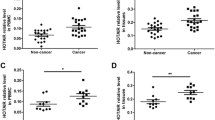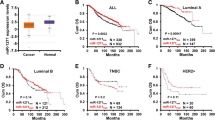Abstract
In estrogen responsive breast cancer cells, estradiol (E2) is a key regulator of cell proliferation and survival. MiR-155 has emerged as an “oncomiR”, which is the most significantly up-regulated miRNA in breast cancer. Moreover, miR-155 is higher in ERα (+) breast tumors than ERα (−), but no one has examined whether E2 regulates miR-155 expression in MCF-7 cells. In this study, the aim was to explore whether miR-155 involved in E2 regulated expression of estrogen responsive genes. We evaluated miR-155 expression in human breast cancer cells by real-time PCR, finding out miR-155 was overexpressed in MCF-7 cells compared with MDA-MB-231 cells. Treatment with E2 in MCF-7 cells increased miR-155 expression, promoting proliferation and decreasing apoptosis, similarly, transfection of miR-155m to MCF-7 cells gave the similar results. In contrast, inhibited miR-155 expression by transfection with miR-155 inhibitors reduced proliferation and promoted apoptosis of MCF-7 cells. Moreover, TP53INP1 is one of the targets of miR-155. E2 negatively regulated TP53INP1 mRNA expression and the protein expression of TP53INP1, cleaved-caspase-3, -8, -9, and p21, whereas transfection with miR-155 inhibitors increased TP53INP1, cleaved-caspase-3, -8, -9, and p21 protein level. These results demonstrated that E2 promoted breast cancer development and progression possibly through increasing the expression of miR-155, which was overexpressed in MCF-7 cells, contributes to proliferation of MCF-7 cells possibly through down-regulating TP53INP1.








Similar content being viewed by others
References
Heldring N, Pike A, Andersson S, Matthews J, Cheng G, Hartman J, Tujague M, Strom A, Treuter E, Warner M, Gustafsson JA (2007) Estrogen receptors: how do they signal and what are their targets. Physiol Rev 87:905–931. doi:10.1152/physrev.00026.2006
Hall JM, Couse JF, Korach KS (2001) The multifaceted mechanisms of estradiol and estrogen receptor signaling. J Biol Chem 276:36869–36872. doi:10.1074/jbc.R100029200
Klinge CM (2009) Estrogen regulation of microRNA expression. Curr Genomics 10:169–183. doi:10.2174/138920209788185289
Ali S, Coombes RC (2002) Endocrine-responsive breast cancer and strategies for combating resistance. Nat Rev Cancer 2:101–112. doi:10.1038/nrc721
Klinge CM (2001) Estrogen receptor interaction with estrogen response elements. Nucleic Acids Res 29:2905–2919
Kushner PJ, Agard DA, Greene GL, Scanlan TS, Shiau AK, Uht RM, Webb P (2000) Estrogen receptor pathways to AP-1. J Steroid Biochem Mol Biol 74:311–317
Safe S (2001) Transcriptional activation of genes by 17 beta-estradiol through estrogen receptor-Sp1 interactions. Vitam Horm 62:231–252
Yu X, Zhang X, Dhakal IB, Beggs M, Kadlubar S, Luo D (2012) Induction of cell proliferation and survival genes by estradiol-repressed microRNAs in breast cancer cells. BMC Cancer 12:29. doi:10.1186/1471-2407-12-29
Bhat-Nakshatri P, Wang G, Collins NR, Thomson MJ, Geistlinger TR, Carroll JS, Brown M, Hammond S, Srour EF, Liu Y, Nakshatri H (2009) Estradiol-regulated microRNAs control estradiol response in breast cancer cells. Nucleic Acids Res 37:4850–4861. doi:10.1093/nar/gkp500
Bartel DP (2009) MicroRNAs: target recognition and regulatory functions. Cell 136:215–233. doi:10.1016/j.cell.2009.01.002
Wickramasinghe NS, Manavalan TT, Dougherty SM, Riggs KA, Li Y, Klinge CM (2009) Estradiol downregulates miR-21 expression and increases miR-21 target gene expression in MCF-7 breast cancer cells. Nucleic Acids Res 37:2584–2595. doi:10.1093/nar/gkp117
Katchy A, Edvardsson K, Aydogdu E, Williams C (2012) Estradiol-activated estrogen receptor alpha does not regulate mature microRNAs in T47D breast cancer cells. J Steroid Biochem Mol Biol 128:145–153. doi:10.1016/j.jsbmb.2011.10.008
Zhao Y, Srivastava D (2007) A developmental view of microRNA function. Trends Biochem Sci 32:189–197. doi:10.1016/j.tibs.2007.02.006
Ventura A, Jacks T (2009) MicroRNAs and cancer: short RNAs go a long way. Cell 136:586–591. doi:10.1016/j.cell.2009.02.005
Yamagata K, Fujiyama S, Ito S, Ueda T, Murata T, Naitou M, Takeyama K, Minami Y, O’Malley BW, Kato S (2009) Maturation of microRNA is hormonally regulated by a nuclear receptor. Mol Cell 36:340–347. doi:10.1016/j.molcel.2009.08.017
Iorio MV, Ferracin M, Liu CG, Veronese A, Spizzo R, Sabbioni S, Magri E, Pedriali M, Fabbri M, Campiglio M, Menard S, Palazzo JP, Rosenberg A, Musiani P, Volinia S, Nenci I, Calin GA, Querzoli P, Negrini M, Croce CM (2005) MicroRNA gene expression deregulation in human breast cancer. Cancer Res 65:7065–7070. doi:10.1158/0008-5472.CAN-05-1783
Zhu W, Qin W, Atasoy U, Sauter ER (2009) Circulating microRNAs in breast cancer and healthy subjects. BMC Res Notes 2:89. doi:10.1186/1756-0500-2-89
Lu J, Tsourkas A (2009) Imaging individual microRNAs in single mammalian cells in situ. Nucleic Acids Res 37:e100. doi:10.1093/nar/gkp482
Kong W, He L, Coppola M, Guo J, Esposito NN, Coppola D, Cheng JQ (2010) MicroRNA-155 regulates cell survival, growth, and chemosensitivity by targeting FOXO3a in breast cancer. J Biol Chem 285:17869–17879. doi:10.1074/jbc.M110.101055
Jiang S, Zhang HW, Lu MH, He XH, Li Y, Gu H, Liu MF, Wang ED (2010) MicroRNA-155 functions as an OncomiR in breast cancer by targeting the suppressor of cytokine signaling 1 gene. Cancer Res 70:3119–3127. doi:10.1158/0008-5472.CAN-09-4250
Kong W, Yang H, He L, Zhao JJ, Coppola D, Dalton WS, Cheng JQ (2008) MicroRNA-155 is regulated by the transforming growth factor beta/Smad pathway and contributes to epithelial cell plasticity by targeting RhoA. Mol Cell Biol 28:6773–6784. doi:10.1128/MCB.00941-08
Han D, Denison MS, Tachibana H, Yamada K (2002) Effects of estrogenic compounds on immunoglobulin production by mouse splenocytes. Biol Pharm Bull 25:1263–1267
Yanaihara N, Caplen N, Bowman E, Seike M, Kumamoto K, Yi M, Stephens RM, Okamoto A, Yokota J, Tanaka T, Calin GA, Liu CG, Croce CM, Harris CC (2006) Unique microRNA molecular profiles in lung cancer diagnosis and prognosis. Cancer Cell 9:189–198. doi:10.1016/j.ccr.2006.01.025
Raponi M, Dossey L, Jatkoe T, Wu X, Chen G, Fan H, Beer DG (2009) MicroRNA classifiers for predicting prognosis of squamous cell lung cancer. Cancer Res 69:5776–5783. doi:10.1158/0008-5472.CAN-09-0587
Nikiforova MN, Tseng GC, Steward D, Diorio D, Nikiforov YE (2008) MicroRNA expression profiling of thyroid tumors: biological significance and diagnostic utility. J Clin Endocrinol Metab 93:1600–1608. doi:10.1210/jc.2007-2696
Ryu JK, Hong SM, Karikari CA, Hruban RH, Goggins MG, Maitra A (2010) Aberrant MicroRNA-155 expression is an early event in the multistep progression of pancreatic adenocarcinoma. Pancreatology 10:66–73. doi:10.1159/000231984
Habbe N, Koorstra JB, Mendell JT, Offerhaus GJ, Ryu JK, Feldmann G, Mullendore ME, Goggins MG, Hong SM, Maitra A (2009) MicroRNA miR-155 is a biomarker of early pancreatic neoplasia. Cancer Biol Ther 8:340–346
Gironella M, Seux M, Xie MJ, Cano C, Tomasini R, Gommeaux J, Garcia S, Nowak J, Yeung ML, Jeang KT, Chaix A, Fazli L, Motoo Y, Wang Q, Rocchi P, Russo A, Gleave M, Dagorn JC, Iovanna JL, Carrier A, Pebusque MJ, Dusetti NJ (2007) Tumor protein 53-induced nuclear protein 1 expression is repressed by miR-155, and its restoration inhibits pancreatic tumor development. Proc Natl Acad Sci USA 104:16170–16175. doi:10.1073/pnas.0703942104
Greither T, Grochola LF, Udelnow A, Lautenschlager C, Wurl P, Taubert H (2010) Elevated expression of microRNAs 155, 203, 210 and 222 in pancreatic tumors is associated with poorer survival. Int J Cancer 126:73–80. doi:10.1002/ijc.24687
Pedersen IM, Otero D, Kao E, Miletic AV, Hother C, Ralfkiaer E, Rickert RC, Gronbaek K, David M (2009) Onco-miR-155 targets SHIP1 to promote TNFalpha-dependent growth of B cell lymphomas. EMBO Mol Med 1:288–295. doi:10.1002/emmm.200900028
Costinean S, Sandhu SK, Pedersen IM, Tili E, Trotta R, Perrotti D, Ciarlariello D, Neviani P, Harb J, Kauffman LR, Shidham A, Croce CM (2009) Src homology 2 domain-containing inositol-5-phosphatase and CCAAT enhancer-binding protein beta are targeted by miR-155 in B cells of Emicro-MiR-155 transgenic mice. Blood 114:1374–1382. doi:10.1182/blood-2009-05-220814
Ferraro L, Ravo M, Nassa G, Tarallo R, De Filippo MR, Giurato G, Cirillo F, Stellato C, Silvestro S, Cantarella C, Rizzo F, Cimino D, Friard O, Biglia N, De Bortoli M, Cicatiello L, Nola E, Weisz A (2012) Effects of oestrogen on microRNA expression in hormone-responsive breast cancer cells. Horm Cancer 3:65–78. doi:10.1007/s12672-012-0102-1
Ito Y, Motoo Y, Yoshida H, Iovanna JL, Takamura Y, Miya A, Kuma K, Miyauchi A (2006) Decreased expression of tumor protein p53-induced nuclear protein 1 (TP53INP1) in breast carcinoma. Anticancer Res 26:4391–4395
Cano CE, Gommeaux J, Pietri S, Culcasi M, Garcia S, Seux M, Barelier S, Vasseur S, Spoto RP, Pebusque MJ, Dusetti NJ, Iovanna JL, Carrier A (2009) Tumor protein 53-induced nuclear protein 1 is a major mediator of p53 antioxidant function. Cancer Res 69:219–226. doi:10.1158/0008-5472.CAN-08-2320
Tomasini R, Samir AA, Vaccaro MI, Pebusque MJ, Dagorn JC, Iovanna JL, Dusetti NJ (2001) Molecular and functional characterization of the stress-induced protein (SIP) gene and its two transcripts generated by alternative splicing. SIP induced by stress and promotes cell death. J Biol Chem 276:44185–44192. doi:10.1074/jbc.M105647200
Tomasini R, Samir AA, Pebusque MJ, Calvo EL, Totaro S, Dagorn JC, Dusetti NJ, Iovanna JL (2002) P53-dependent expression of the stress-induced protein (SIP). Eur J Cell Biol 81:294–301
Okamura S, Arakawa H, Tanaka T, Nakanishi H, Ng CC, Taya Y, Monden M, Nakamura Y (2001) p53DINP1, a p53-inducible gene, regulates p53-dependent apoptosis. Mol Cell 8:85–94
Jiang PH, Motoo Y, Garcia S, Iovanna JL, Pebusque MJ, Sawabu N (2006) Down-expression of tumor protein p53-induced nuclear protein 1 in human gastric cancer. World J Gastroenterol 12:691–696
Tomasini R, Seux M, Nowak J, Bontemps C, Carrier A, Dagorn JC, Pebusque MJ, Iovanna JL, Dusetti NJ (2005) TP53INP1 is a novel p73 target gene that induces cell cycle arrest and cell death by modulating p73 transcriptional activity. Oncogene 24:8093–8104. doi:10.1038/sj.onc.1208951
Yanamadala V, Negoro H, Denker BM (2009) Heterotrimeric G proteins and apoptosis: intersecting signaling pathways leading to context dependent phenotypes. Curr Mol Med 9:527–545
Walsh JG, Cullen SP, Sheridan C, Luthi AU, Gerner C, Martin SJ (2008) Executioner caspase-3 and caspase-7 are functionally distinct proteases. Proc Natl Acad Sci USA 105:12815–12819. doi:10.1073/pnas.0707715105
Gutzman JH, Nikolai SE, Rugowski DE, Watters JJ, Schuler LA (2005) Prolactin and estrogen enhance the activity of activating protein 1 in breast cancer cells: role of extracellularly regulated kinase 1/2-mediated signals to c-fos. Mol Endocrinol 19:1765–1778. doi:10.1210/me.2004-0339
van den Berg A, Kroesen BJ, Kooistra K, de Jong D, Briggs J, Blokzijl T, Jacobs S, Kluiver J, Diepstra A, Maggio E, Poppema S (2003) High expression of B-cell receptor inducible gene BIC in all subtypes of Hodgkin lymphoma. Genes Chromosomes Cancer 37:20–28. doi:10.1002/gcc.10186
Xiao B, Liu Z, Li BS, Tang B, Li W, Guo G, Shi Y, Wang F, Wu Y, Tong WD, Guo H, Mao XH, Zou QM (2009) Induction of microRNA-155 during Helicobacter pylori infection and its negative regulatory role in the inflammatory response. J Infect Dis 200:916–925. doi:10.1086/605443
Yin Q, Wang X, McBride J, Fewell C, Flemington E (2008) B-cell receptor activation induces BIC/miR-155 expression through a conserved AP-1 element. J Biol Chem 283:2654–2662. doi:10.1074/jbc.M708218200
Yin Q, McBride J, Fewell C, Lacey M, Wang X, Lin Z, Cameron J, Flemington EK (2008) MicroRNA-155 is an Epstein-Barr virus-induced gene that modulates Epstein-Barr virus-regulated gene expression pathways. J Virol 82:5295–5306. doi:10.1128/JVI.02380-07
Dai Y, Diao Z, Sun H, Li R, Qiu Z, Hu Y (2011) MicroRNA-155 is involved in the remodelling of human-trophoblast-derived HTR-8/SVneo cells induced by lipopolaccharides. Hum Reprod 26:1882–1891. doi:10.1093/humrep/der118
Acknowledgments
We are grateful to the Stem Cell and Tissue Engineering Lab at Chongqing Medical University for providing experimental equipments, and thank all staff in this lab for their help and advice. We also thank the Institute of Life Sciences for providing the technical assistance of cell cycle analysis, cell apoptosis analysis, Immunofluorescence, and Real-time quantitative PCR.
Author information
Authors and Affiliations
Corresponding author
Rights and permissions
About this article
Cite this article
Zhang, C., Zhao, J. & Deng, H. 17β-Estradiol up-regulates miR-155 expression and reduces TP53INP1 expression in MCF-7 breast cancer cells. Mol Cell Biochem 379, 201–211 (2013). https://doi.org/10.1007/s11010-013-1642-6
Received:
Accepted:
Published:
Issue Date:
DOI: https://doi.org/10.1007/s11010-013-1642-6




